- Titel: Contemplaties, De Christus en de antichristus.
- Auteur: Arvindus.
- Uitgever: Arvindus.
- Auteursrecht: Arvindus, 2023, alle rechten voorbehouden.
- Index: 202311082.
- Editie: html, tweede editie.
- Origineel: Contemplations, The Christ and the Antichrist, Index: 202311081.
Inleiding
Doorheen de eeuwen hebben mensen de antichristus evenveel gevreesd als dat ze de Christus hebben liefgehad, en misschien zelfs wel meer. In deze contemplatie zullen enkele van de aspecten van voorgenoemden verkend worden, begeleid door de tijdloze wijsheid.
De cyclus van involutie en evolutie
In de tijdloze wijsheid wordt gewag gemaakt van het bestaan van zogenaamde 'globeronden'.1 Technisch constitueren zeven planetaire globes een planetaire keten, zoals zeven van die ketens een planetair schema constitueren.2 Zo'n planetair schema is het lichaam van manifestatie van een planetaire logos, heel vergelijkbaar met zoals een menselijk lichaam het lichaam van manifestatie is van een menselijke monade.3 En net zoals een menselijke monade zich ontwikkelt via lichamelijke incarnaties, zijnde cycli van manifestatie, ontwikkelt een planetaire logos zich via zijn cycli van manifestatie. Een planetaire logos ontwikkelt zich via één schemaronde, zeven ketenronden en negenenveertig globeronden.4 En de aarde waarop we leven betreft de vierde globe van de vierde keten.5
Boven werd melding gemaakt van cycli van manifestatie. Zo'n cyclus is tweevoudig en bestaat uit een periode van involutie en een periode van evolutie.6 Tijdens involutie daalt de geest neer en wordt deze gevangen in materie en tijdens evolutie ontsnapt de geest aan de greep van materie door deze te vergeestelijken. Dus een cyclus van manifestatie kan gesymboliseerd worden door een volle cirkel die bestaat uit een afdalende helft en een opstijgende helft.7
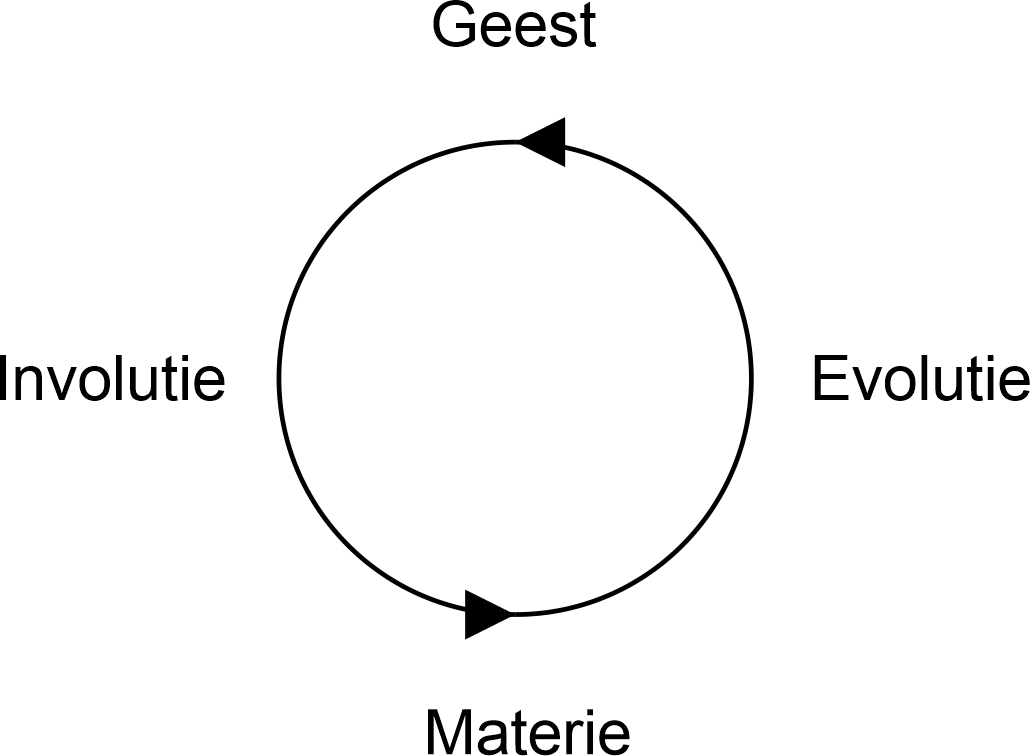
Figuur 1.
De Bijbel
Opmerkelijk genoeg worden de bovenstaande fasen van involutie en evolutie weerspiegeld in Het oude testament en Het nieuwe testament van De bijbel. Het oude testament is eerder materialistisch georiënteerd met zijn centrale thema van het 'uitverkoren' volk dat zich afscheidt van alle andere volkeren terwijl Het nieuwe testament eerder spiritualistisch georiënteerd is met zijn centrale thema van de liefde die alle mensen verenigt.8, 9, 10
Exemplarisch in Het oude testament voor de fase van involutie van geest naar materie betreft het verhaal van Adam en Eva. Adam en Eva leefden in onwetende heerlijkheid in de Tuin van Eden. In het midden van deze tuin groeide een boom die vruchten gaf die, wanneer ervan werd gegeten, de kennis van goed en kwaad zou geven, de eter gelijkmakend aan God. God had het verboden om deze vruchten te eten, maar de slang verleidde Eva tot het eten daarvan, waarna Eva ook Adam overtuigde om hetzelfde te doen. Dit maakte God boos, en Adam en Eva werden verbannen uit de Tuin van Eden om een pijnlijk leven te leiden buiten deze tuin.11
In deze mythe symboliseert Adams en Eva's leven in de Tuin van Eden de menselijke geest van vóór de aanvang van fysieke incarnatie, de cyclus van inwikkeling en ontwikkeling, involutie en evolutie. Het verbannen van Adam en Eva uit de Tuin van Eden symboliseert dan de neerdaling van de geest in materie. En het verkrijgen van de kennis van goed en slecht symboliseert dan het bewustzijn dat ontstaat wanneer geest in materie neerdaalt.12, 13 Wanneer de menselijke geest zijn incarnatie in een menselijk lichaam aanvangt dan ontstaat er zelfbewustzijn.14 Dit zelfbewustzijn wordt in de voorgenoemde mythe gesymboliseerd door het bewust worden van Adam en Eva van hun naaktheid.15
Exemplarisch in Het nieuwe testament voor de fase van evolutie van materie naar geest betreft in principe het gehele leven van Jezus van Nazareth. De ontwikkeling van de mens loopt via een serie van demarcatiepunten waarop zijn niveau van bereiking wordt bevestigd. In de tijdloze wijsheid worden dit 'inwijdingen' genoemd. De eerste inwijding bevestigt de controle van de mens op het fysiek gebied, de tweede op het astraal of emotie-gebied, de derde op het mentaal gebied, de vierde op het buddhisch of intuïtie-gebied en de vijfde op het atmisch of wil-gebied.16 En deze inwijdingen worden dan gesymboliseerd in het leven van Jezus door zijn geboorte, doop, transfiguratie, kruisiging en opstanding / hemelvaart.17
Liefde en haat
Boven werd de fase van menselijke opgang beschreven als lopende van het fysiek gebied doorheen het astraal of emotie-, manasisch of denk-, buddhisch of intuïtie- en atmisch of wil-gebied. Er is echter nog één extra gebied waar doorheen gegaan moet worden voordat het goddelijk gebied van de absolute geest wordt bereikt, en dit betreft het monadisch gebied.18 We krijgen dus een overzicht als hieronder.
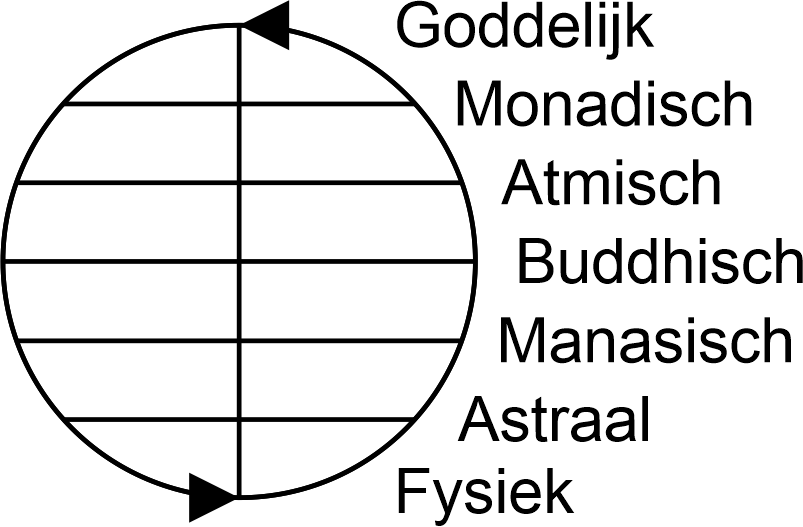
Figuur 2.
In dit overzicht van de zeven gebieden zien we dat het buddisch of intuïtie-gebied de middenpositie bezet tussen het goddelijk en fysiek gebied, net zoals bewustzijn een middenpositie bezet tussen geest en materie, en het is daarom dat het menselijk bewustzijn het breedst is op het buddhisch gebied: bewustzijn strekt zich daar uit van kwaad op de neerwaartse boog tot aan goed op de opwaartse boog.19
Het kan gezegd worden dat op de neerwaartse boog bewustzijn haat gebruikt om te bewegen van de eenheid van geest naar de diversiteit van materie en op de opwaartse boog liefde om te bewegen van de diversiteit van materie naar de eenheid van geest.20 En omdat we in de huidige tijden geplaatst zijn op de opwaartse boog van evolutie wordt de diversifiërende haat beschouwd als kwaadaardig en de verenigende liefde als goedaardig, ofschoon vanuit het groter perspectief, dat van de gehele cyclus, beide hun geëigende plaats hebben.21, 22
De Christus en de antichristus
Boven werd vermeld dat op het buddhisch gebied het menselijk bewustzijn het breedst is. Op de opwaartse boog is het buddhisch gebied ook het gebied waar de intuïtie en de liefde worden gevonden. In de tijdloze wijsheid wordt dit principe gekend als 'liefde-wijsheid', maar het wordt ook 'het Christus-principe' genoemd.23 Daarom is het dat een wezen dat het principe van liefde belichaamt op zijn eigen gebied 'een Christus' genoemd kan worden. In de Aard-hiërarchie bijvoorbeeld wordt het wezen dat het liefdesprincipe belichaamt voor de aarde 'de Christus' genoemd,24, 25 maar er is ook een zelfs grootser wezen dat het liefdesprincipe belichaamt voor het zonnestelsel, en dit wezen wordt 'de kosmische Christus' genoemd.26 De reden dat Jezus van Nazareth ook 'Jezus Christus' wordt genoemd is omdat tijdens zijn leven hij overschaduwd werd door de Christus van de Aard-hiërarchie.27
De tegenpool van het Christusprincipe nu is natuurlijk het antichristusprincipe, en wezens die dit principe belichamen kunnen dan 'antichristus' genoemd worden. Zij belichamen het principe van haat en involutie.28 En langs deze lijn van denken kan de antichristus, genoemd in Het nieuwe testament,29 voor deze aarde inderdaad gelijkgesteld worden aan de slang van de boven vertelde mythe van Het oude testament. Andere namen die worden toegepast in De bijbel zijn 'Satan', 'Lucifer', 'het beest' en 'de duivel'.
De naam 'Satan' is direct overgenomen van het Hebreeuwse woord 'satan', dat refereert aan een tegenstander of een tegenstand.30, 31 En inderdaad is de antichristus een tegenstander en een tegenstand van de Christus. De antichristus wordt ook beschouwd de referent te zijn wanneer in Het oude testament de morgenster wordt genoemd,32 waarvan de naam 'Lucifer' betreft.33, 34 'De morgenster' refereert in zijn algemeenheid echter aan de planeet Venus,35 en volgens de tijdloze wijsheid vond individualisatie, betekenend het tot aanzijn komen van zelfbewustzijn,36 plaats onder de invloed van Venus.37 Venus, Lucifer, de slang, de antichristus, involutie, gaf de mensheid zelfbewustzijn, de kennis van goed en kwaad. Daarvoor was de mens niet meer dan een dier,38 en dit is waaraan de naam 'het beest' kan refereren. De antichristus is het beest omdat het als een principe ervoor zorgt dat de geest gevangen wordt in materiële, dierlijke lichamen.39 En deze antichristus wordt ook gekend als 'de duivel'.40 Deze naam stamt van het originele Griekse 'diabolos' van Het nieuwe testament, refererend aan een kwaadspreker,41, 42 wat de antichristus zeer zeker is.
In de tijdloze wijsheid wordt deze duivelse antichristus ook "De Wachter op de Drempel" genoemd, die op een individuele schaal de persoonlijkheid van de mens, bestaande uit zijn lagere faculteiten van lichaam, emotie en concreet denken, vertegenwoordigt.43, 44 En deze "Wachter op de Drempel" wordt dan tegenover de zogenoemde "Engel van de Tegenwoordigheid" gezet, een naam die refereert aan de ziel of het Christusprincipe.45, 46
Kruizen
De Christus als Jezus Christus is natuurlijk beroemd vanwege zijn kruisiging, en het kruis is het primaire symbool geworden van het Christendom als een religie.47 Interessant genoeg is er ook een duidelijke fonetische overeenkomstigheid tussen de naam 'Christus' en het woord 'kruis'. Etymologisch wordt het woord 'kruis' herleid tot het Latijnse 'crux' of 'crucis', wat opnieuw een vergelijkbare fonetiek heeft met het Latijnse 'Christus', waaraan het Nederlandse 'Christus werd ontleend.48, 49
Nu is het al vaak gecontempleerd dat het kruis in de cirkel of perifeer bewustzijn uitstekend symboliseert,50 en met bewustzijn op onze opgaande boog het Christusprincipe benadrukkend wordt dit symbool vaak genomen als eenvoudigweg dit principe te representeren.51 We zien zo'n symbool hieronder weergegeven.
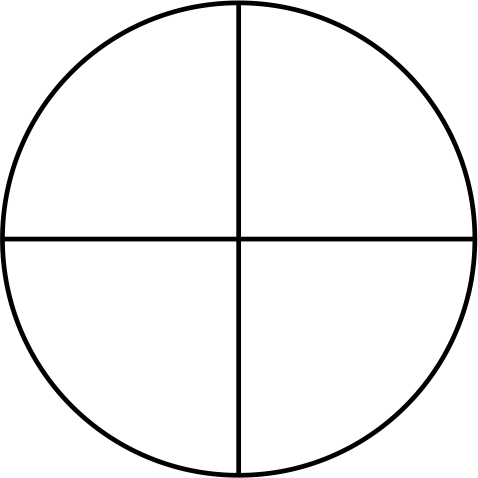
Figuur 3.
Zoals eerder getoond in deze contemplatie bevat bewustzijn echter niet alleen het Christusprincipe maar ook het antichristusprincipe. En deze twee principes kunnen worden weergegeven in twee afzonderlijke symbolen die echter gebaseerd zijn op het bovenstaande synthetische symbool. Dit zien we hieronder gedaan. Het figuur links symboliseert het antichristusprincipe. We zien opnieuw een kruis in een perifeer, echter het figuur vindt zijn zwaartepunt aan de materiële zijde. Terug refererend aan figuur 2 van deze contemplatie kan gezegd worden dat het bewustzijn van de antichristus gericht is op de lagere gebieden van het bestaan.
Het figuur rechts symboliseert dan het eigenlijke Christusprincipe. En met zijn nadruk op de spirituele zijde is de Christus gericht op de hogere gebieden van het bestaan.52
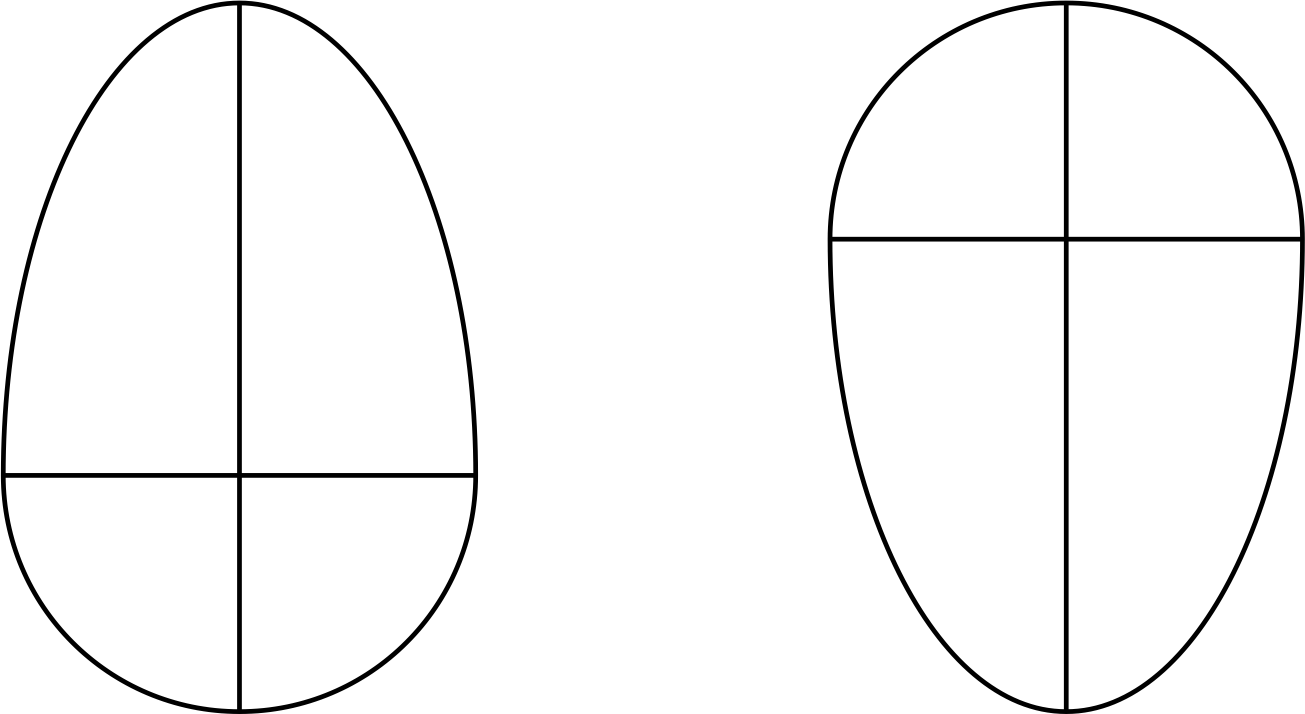
Figuren 4, 5.
Zoals nu boven werd geïndiceerd wordt het symbool van het kruis door Christenen ontleend aan de kruisiging van Jezus Christus. En dit beeld van de gekruisigde Christus versiert de Christelijke kerken en huizen. Hieronder is zo'n beeld getekend.
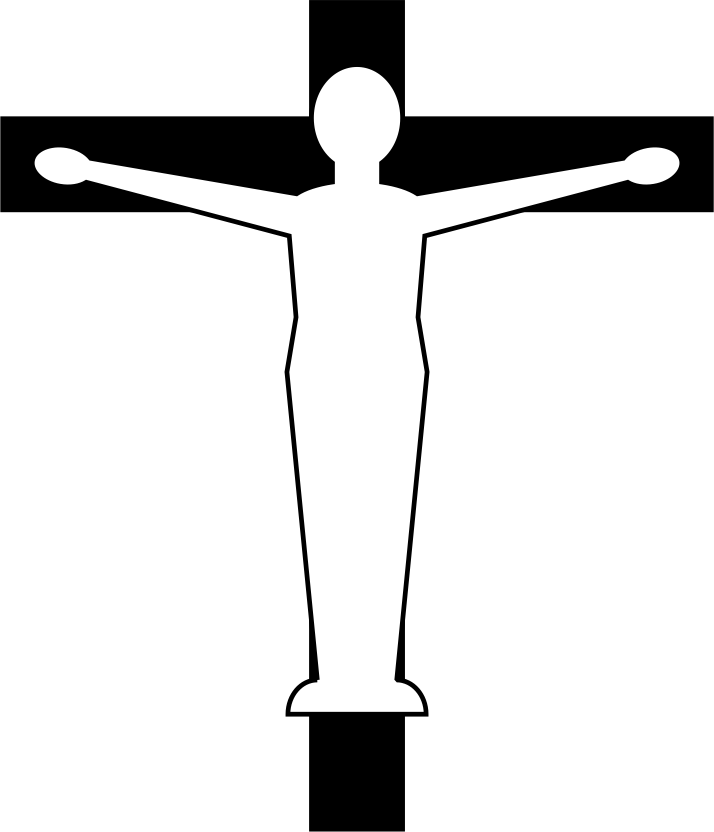
Figuur 6.
Hoewel nu op onze opgaande boog het beeld van de gekruisigde Christus opgevat wordt als enkel de Christus te symboliseren bevat het vanuit een groter perspectief symbolen voor zowel de Christus als de antichristus. Want de Christus kan van het kruis afgehaald worden, en wanneer dit wordt gedaan dan worden een afzonderlijk kruis en een afzonderlijke Christus gezien. Het gestripte kruis symboliseert dan de antichristus, want dat kruis is de tegenstander bij uitstek van de Christus. Wanneer de Christus gekruisigd is houdt het kruis van de antichristus, zijnde het kruis van materie, de evolutie van de Christus naar de geest gebonden aan zichzelf.53 Wanneer echter de Christus wordt bevrijd van het kruis van materie dan vormt hij zelf een hemels kruis, met zijn armen omhoog geheven in zegening.54, 55
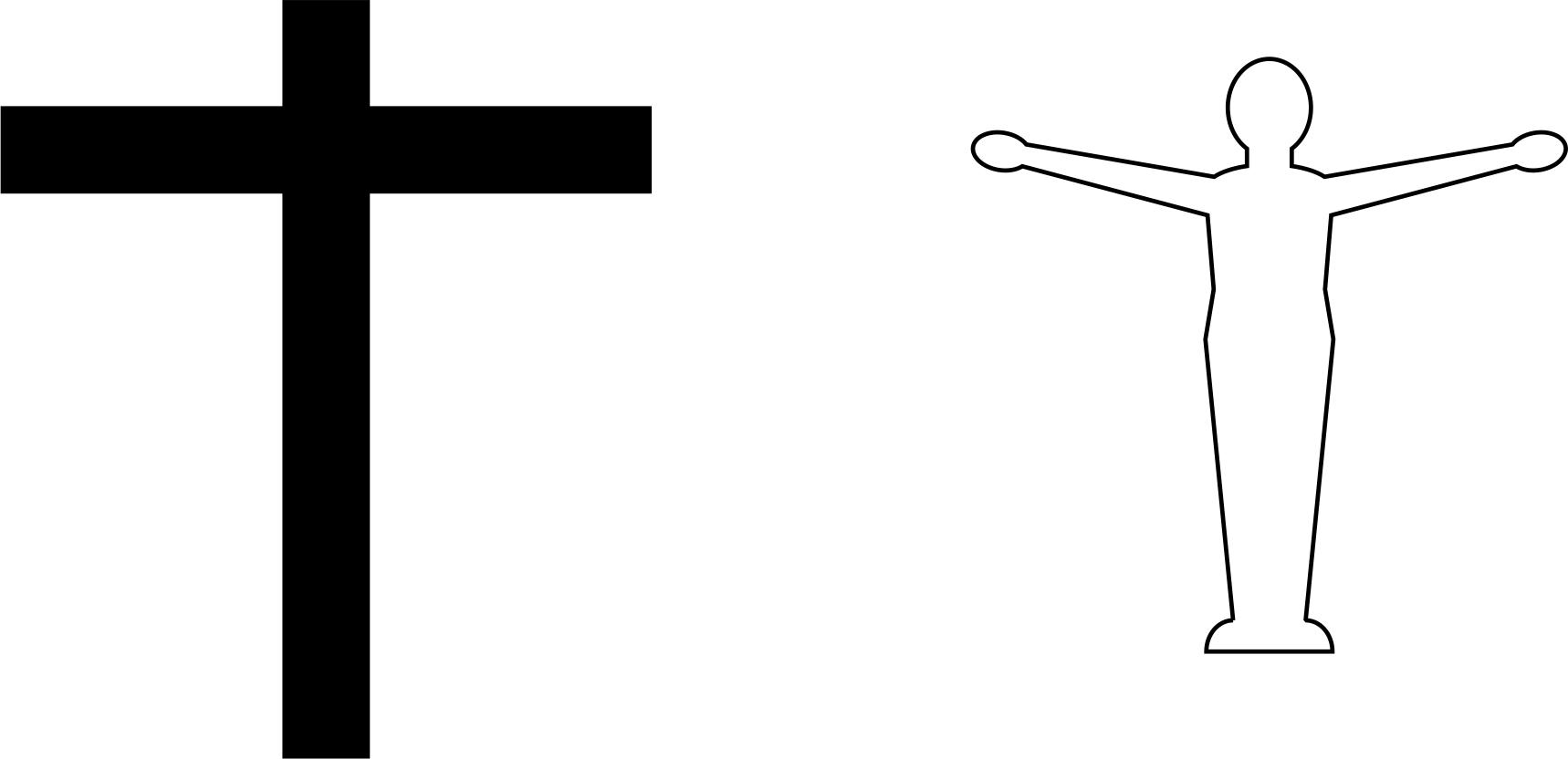
Figuren 7, 8.
666 en 777
Boven werden diverse namen voor de antichristus gegeven, maar hij is natuurlijk ook goedbekend vanwege zijn toegekende nummer, zijnde 666.56 En dit nummer wordt dan tegen het nummer 777 afgezet. Het nummer 7 wordt daarbij beschouwd als het nummer van (menselijke en relatieve) perfectie.57 Alles in de natuur kan volgens de tijdloze wijsheid beschouwd worden als zevenvoudig.58 Er zijn zeven gebieden, zeven menselijke principes, zeven chakra's, enzovoort.59 En in De Bijbel kunnen we lezen dat God de zevende dag zegende, de dag waarop hij rustte na zijn schepping.60 In dit licht kan het nummer 6 dan gezien worden als het nummer van imperfectie en van werk. Het nummer 7 is dat van de geest, van het begin en het einde,61 en het nummer 6 dat van materie, van de cyclus door de zes sub-geestelijke niveaus van geest naar geest.62
We zien dit weerspiegeld in de nummers 777 en 666. In de tijdloze wijsheid is het nummer 777 het symbool van de drie fasen waardoorheen de mens gaat om perfectie te bereiken. Deze fasen worden gesymboliseerd door de nummers 700, 70 en 7.63 De nummers 600, 60 en 6, samen 666 vormend, symboliseren dan de imperfectie van deze fasen en cyclus. In principe indiceert 666 een oriëntatie op involutie naar materie en 777 op evolutie naar geest.64
Samenvatting
We gingen op pad om (aspecten van) de antichristus en de Christus te contempleren en vonden dat in het groter plaatje ze principes betreffen, namelijk die van involutie en evolutie. Maar we vonden ook dat deze principes belichaamd kunnen worden door wezens op verschillende niveaus. Op het planetair niveau van de aarde bijvoorbeeld kan 'de Christus' refereren aan het belangrijkste wezen dat liefde hanteert en 'de antichristus' aan het belangrijkste wezen dat haat hanteert. Maar deze liefde en deze haat zijn ook aanwezig op individueel niveau waar de eerstgenoemde wordt vertegenwoordigd door onze eigen "Engel van de Aanwezigheid" en de laatstgenoemde door onze eigen "Wachter op de Drempel".
Symbolisch werden deze twee energieën weergegeven met kruizen in periferen, die van de antichristus met zijn zwaartepunt naar beneden en die van de Christus met zijn zwaartepunt omhoog. En we zagen ook hoe het Christelijke beeld van Jezus Christus aan het kruis deze twee energieën symboliseert.
Nummerologisch zagen we tenslotte 666 staan voor de ongepefectioneerde antichristus met zijn oriëntatie op materie en 777 voor de geperfectioneerde Christus met zijn oriëntatie op geest.
Dus om af te sluiten: De antichristus is het haatprincipe van involutie van de eenheid van geest naar de diversiteit van materie, en de Christus is het liefdesprincipe van evolutie van de diversiteit van materie naar de eenheid van geest. Maar, en dit moet niet vergeten worden, ze komen voor als tegengestelden binnen één cyclus van bewustzijn. En dit is ook waarom in De bijbel de antichristus en de Christus beiden geïdentificeerd kunnen worden met dezelfde morgenster.65, 66 In ruimere zin zijn ze één.
Noten
- 'Ageless Wisdom, Cycles', Index: 201403131.
- Ibidem.
- 'Ageless Wisdom, Logoi', Index: 202304272. "Now the Earth scheme is the body of manifestation of a planetary logos, comparable with the way the body of a man is the manifestation of a human monad.".
-
Alice A. Bailey, A Treatise on Cosmic Fire, in: Twenty-Four Books of Esoteric Philosophy, (CD-ROM, Release 3), Lucis Trust, London / New York, 2001, p. 382-383. "A scheme, in its totality, corresponds to the Monad, or to the monadic auric egg, in connection with a human being and his forty-nine cycles.
A chain, in its totality corresponds to the body egoic of a human being, to the causal body with its seven great cycles mentioned elsewhere in these pages, and hinted at in certain occult books.
A globe, with its seven races corresponds to a particular series of incarnations in connection with a man, incarnate or discarnate, for all globes are not on physical levels.
A physical globe, in a chain corresponds to a particular physical incarnation of a man. The planetary Logos takes physical form in His planet and is its life and works out His purposes." - Ibidem, p. 459. "It is of peculiar interest at this time that we are in the fourth round in a chain as well as in the fourth round as regards the scheme of seven chains."
- 'Cycles', The Law of Cycles / Figure 1: The Cycle of the Seven Globes / Figure 2: The Cycle of the Seven Root Races.
- 'Contemplations, The Quadrants of the Cross in the Circle and the Cycle of Manifestation and Obscuration', Index: 201705031.
- Alice A. Bailey, From Bethlehem to Calvary, in: Twenty-Four Books of Esoteric Philosophy, (CD-ROM, Release 3), Lucis Trust, London / New York, 2001, p. 106. "The Old Testament stands for the natural lower man, the virgin Mary aspect, carrying within itself the promise of the Messiah, of Him Who shall come. The New Testament stands for the spiritual man, for God made flesh, and for the birth of that which the material nature carried and veiled for so long. The Old Testament opens with the appearance of the raven at the time of the founding of the ancient world, as we can begin to know it. The New Testament opens with the appearance of a dove—one the symbol of the raging waters, the other the symbol of the waters of peace. Through Christ and the unfoldment of the Christ life in each human being will come "the peace which passeth understanding.""
- Alice A. Bailey, Esoteric Healing, A Treatise on the Seven Rays, Volume IV, in: Twenty-Four Books of Esoteric Philosophy, (CD-ROM, Release 3), Lucis Trust, London / New York, 2001, p. 267-268. "Let me point out also that just as the Kabbalah and the Talmud are secondary lines of esoteric approach to truth, and materialistic in their technique (embodying much of the magical work of relating one grade of matter to the substance of another grade), so the Old Testament is emphatically a secondary Scripture, and spiritually does not rank with the Bhagavad-Gita, the ancient Scriptures of the East and the New Testament. Its emphasis is material and its effect is to impress a purely materialistic Jehovah upon world consciousness. The general theme of the Old Testament is the recovery of the highest expression of the divine wisdom in the first solar system; that system embodied the creative work of the third aspect of divinity—that of active intelligence, expressing itself through matter. In this solar system, the created world is intended to be the expression of the second aspect, of the love of God. This the Jew has never grasped, for the love expressed in the Old Testament is the separative, possessive love of Jehovah for a distinct unit within the fourth or human kingdom. St. Paul summed up the attitude which humanity should assume in the words: "There is neither Jew nor Gentile.""
- Alice A. Bailey, Education in the New Age, in: Twenty-Four Books of Esoteric Philosophy, (CD-ROM, Release 3), Lucis Trust, London / New York, 2001, p. 144. "The soul body is in process of being slowly constructed, and is that "house not made with hands, eternal in the heavens" to which the New Testament refers (II Cor. 5: l). It is interesting to note that the Old Testament refers to the etheric body (Ecc. 12:6-7) and its construction, and the New Testament deals with the building of the spiritual body."
- The American Standard Old Testament, (software), Version 1.0, Ages Software, Albany, 1996, Genesis, Ch. 3.
- 'Ageless Wisdom, Triplicities in Man', Index: 201308292.
- Alice A. Bailey, The Consciousness of the Atom, in: Twenty-Four Books of Esoteric Philosophy, (CD-ROM), Lucis Trust, London / New York, 2001, p. 86-87. "We have, nearly all of us, been brought up in the belief in what is called "the fall of man." There are few these days who believe the story of the fall as it is given in the third chapter of Genesis, and we most of us credit it as having an allegorical interpretation. What is the occult truth underlying this curious story? Simply that the truth about the fall of the spirit into matter is conveyed by means of a picture to the infant mentality of man. The process of the converging of these lines is a twofold one. You have the descent into matter of the entity, of the central life, and the incarnation of spirit, and then you have the working up, out of matter, of that life or spirit, plus all that has been gained through the utilisation of form. By experimenting with matter, by dwelling within the form, by the energising of substance, by the going out of the Garden of Eden (the place where there is no scope for necessary development), and by the wandering of the Prodigal Son in the far country, you have the various stages which are pictured in the Christian Bible where man makes the discovery that he is not the form, but that he is the one who utilises it. He is intelligence, and therefore he is made in the image of the third Person of the Trinity; he is love, and through him the love aspect of the Deity will some day perfectly manifest, and he will be able to say with his elder Brother, the Christ, in reply to the demand "Lord, show us the Father," that "he that hath seen me, hath seen the Father," for God is Love; and finally, through him the highest aspect, the will of God will become manifest, and he will be perfect, even as his Father in heaven is perfect."
- 'Ageless Wisdom, The Egoic Lotus', Index: 201305241, The Egoic Lotus as Cause of Individuality.
- Nota 11.
- Alice A. Bailey, The Rays and the Initiations, A Treatise on the Seven Rays, Volume V, in: Twenty-Four Books of Esoteric Philosophy, (CD-ROM, Release 3), Lucis Trust, London / New York, 2001, p. 340.
- From Bethlehem to Calvary.
- 'Ageless Wisdom, Man on the Planes', Index: 201212031.
- 'Contemplations, The Cross in the Circle: Consciousness and Duality', Index: 201510131.
- From Bethlehem to Calvary, p. 205. "Love is unity, at-one-ment and synthesis. Separateness is hatred, aloneness and division."
- 'Questions, How Can the Concepts of Black and White Magic Be Understood?', Index: 202304301.
- Geert Crevits, Morya Wijsheid 4: Vertrouwen in jezelf, Mayil Publishing House, 2007, H. 1, translated. "For hate can do as much as love, but it is a totally different power. It is a destoying power which even so also can be used by the Divine."
-
Alice A. Bailey, Letters on Occult Meditation, in: Twenty-Four Books of Esoteric Philosophy, (CD-ROM, Release 3), Lucis Trust, London / New York, 2001, p. 0. "II. The Ego, Higher Self, or Individuality.
This aspect is potentially :—
1. Spiritual Will Atma 2. Intuition Buddic, Love-Wisdom, the Christ principle. 3. Higher or abstract Mind Higher Manas." - Benjamin Creme, Maitreya's Mission, Volume I, Share International Foundation, London, 2010, p. 5. "The Lord Maitreya, who embodies the Christ Principle, is the Master of all the Masters, the head and leader of that group of enlightened men."
- Ibidem, p. 3. "The Christ is Maitreya, Who manifested Himself by overshadowing His disciple, Jesus, just as the Buddha overshadowed His disciple, the Prince Gautama."
- 'Ageless Wisdom, Logoi'.
- Nota 25.
- Benjamin Creme, Maitreya's Mission, Volume Three, Share International, Foundation, London, 1997, p. 385-386. "The Antichrist is not a man, as Christians believe, who will come out before the Christ, and could even be mistaken for the Christ. The idea comes from the Revelation of St John: the Beast, 666, is unchained for a time, and then chained down for a time and half a time. This refers to the release of the energy we call the Antichrist. It is not a man but an energy, a destructive force which is deliberately released to break down the old order, the old civilization. It was released in John's own day, through the Emperor Nero, to bring about the end of the Roman dispensation, to prepare the way for Christendom. It was released again in our time through Hitler, a group of equally evil men around him in Nazi Germany, together with a group of militarists in Japan and a further group around Mussolini in Italy. These three groups, the Axis powers in the war from 1939 to 1945, embodied the energy we call the Antichrist."
- The American Standard New Testament, (software), Version 1.0, Ages Software, Albany, 1996, John 1, John 2.
- Oxford English Dictionary, Second Edition on CD-ROM (v. 4.0), Oxford University Press, 2009, Satan.
- Encyclopædia Britannica, Ultimate Reference Suite, Version 2015, (software), Encyclopædia Britannica, 2015, Satan.
- The American Standard Old Testament, Isaiah, Ch. 14, v. 12. "How art thou fallen from heaven, O day-star, son of the morning!"
- Oxford English Dictionary, Lucifer, 2.
- Encyclopædia Britannica, Lucifer (classical mythology). "in classical mythology, the morning star (i.e., the planet Venus at dawn); personified as a male figure bearing a torch, Lucifer had almost no legend, but in poetry he was often herald of the dawn. In Christian times Lucifer came to be regarded as the name of Satan before his fall."
- Ibidem.
- A Treatise on Cosmic Fire, p. 458. "3. During the third rootrace, animal individualisation took place, and the self-conscious unit, called Man, came into being."
- Ibidem, p. 1076. "This was what made it possible to utilise Venusian energy upon the Venus chain and the Venus globe of our scheme and thus cause the phenomenon of forced individualisation in Lemurian days."
- Alice A. Bailey, Esoteric Psychology, Volume I, A Treatise on the Seven Rays, Volume I, in: Twenty-Four Books of Esoteric Philosophy, (CD-ROM, Release 3), Lucis Trust, London / New York, 2001, p. 415. "3. The animal kingdom is the field of individualisation."
- Alice A. Bailey, A Treatise on White Magic, in: Twenty-Four Books of Esoteric Philosophy, (CD-ROM, Release 3), Lucis Trust, London / New York, 2001, p. 240. "It is interesting to note that the work of the Devil, the imprisoner of souls, […]."
- Oxford English Dictionary, devil, n., 1.
- Ibidem, devil, n.
- Henry George Liddell / Robert Scott, A Greek-English Lexicon, Oxford University Press, Oxford, 1996, p.390.
- From Bethlehem to Calvary, p. 119. "Thus He was confronted with the Dweller on the Threshold, which is only another name for the personal lower self, regarding it as a unified whole, as is only the case in advanced people, disciples and initiates. In these three words—maya, glamour and illusion—we have synonyms for the flesh, the world and the devil, which constitute the threefold test that confronts every son of God on the verge of liberation."
- Nota 12.
-
Alice A. Bailey, Glamour: A World Problem, in: Twenty-Four Books of Esoteric Philosophy, (CD-ROM, Release 3), Lucis Trust, London / New York, 2001, p. 163-164. "The work being done by those who see the world stage as the arena for the conflict between the Dweller on the Threshold and the Angel of the PRESENCE might be itemised as:
1. The producing of those world conditions in which the Forces of Light can overcome the Forces of Evil. […].
2. The educating of humanity in the distinction between:
a. Spirituality and materialism, […].
b. Sharing and greed, […].
c. Light and dark, […].
d. Fellowship and separation, […].
e. The whole and the part, […]." - The Rays and the Initiations, p. 176. "At the later initiations, the Angel of the Presence is the Christ Himself, one with the soul of the candidate (the individual Angel of the Presence)."
- Encyclopædia Britannica, cross. "the principal symbol of the Christian religion, recalling the Crucifixion of Jesus Christ and the redeeming benefits of his Passion and death. The cross is thus a sign both of Christ himself and of the faith of Christians.
- Oxford English Dictionary, cross, n.
- Ibidem, Christ.
- Nota 19.
- 'Contemplations, Etymological and Esoteric Roots of 'Arch', 'Arc' and 'Ark'', Index: 201103261. "Through this fecundation the Christ principle is born, symbolized as the cross in the circle."
- Note how the periphery of this symbol brings about the visionary artistic eye perspective as contemplated in 'Contemplations, The Visionary Artistic Eye Perspective', Index: 201708081.
- From Bethlehem to Calvary, p. 184-185. "Christ can be seen crucified. Down the ages human beings have symbolised the cosmic Christ immolated upon the cross of matter, and thus have perpetuated in the consciousness of the race the knowledge of that event; so in a planetary sense, the four kingdoms of nature do the same, portraying the spirit of God stretched upon a cross of material form, in order eventually to make possible the appearance of the kingdom of God on Earth. This connotes the spiritualisation of matter and form, the assumption of matter into heaven, and the release of God from the cosmic crucifixion."
-
Ibidem, p. 181. "The Crucifixion and the Cross of Christ are as old as humanity itself. Both are symbols of the eternal sacrifice of God as He immerses Himself in the form aspect of nature and thus becomes God immanent as well as God transcendent.
We have seen that Christ must be recognised, first of all, in the cosmic sense. The cosmic Christ has existed from all eternity. This cosmic Christ is divinity, or spirit, crucified in space. He personifies the immolation or sacrifice of spirit upon the cross of matter, of form or substance, in order that all divine forms, including the human, may live. This has ever been recognised by the so-called pagan faiths. If the symbolism of the cross is traced far back, it will be found that it antedates Christianity by thousands of years, and that finally, the four arms of the cross will be seen to drop away, leaving only the picture of the living Heavenly Man, with His arms outspread in space. North, south, east and west stands the cosmic Christ upon what is called "the fixed cross of the heavens." Upon this cross God is eternally crucified." - Jesus, in: Baird T. Spalding, Life and Teaching of the Masters of the Far East, Volume II, DeVorss & Co., Los Angeles, 1944, p. 55. "The cross was, in the beginning, the symbol of the greatest joy the world ever knew. The foundation of the cross is the place where man first trod the earth, therefore, the mark that symbolizes the dawn of a celestial day here on earth. If you will trace it back, you will find that the cross disappears entirely and that it is the man standing in the attitude of devotion, standing in space with arms upraised in blessing, sending out his gifts to humanity, pouring all his gifts forth freely in every direction."
- The American Standard New Testament, Revelation, Ch. 13, v. 18. "He that hath understanding, let him count the number of the beast; for it is the number of a man: and his number is Six hundred and sixty and six."
- The Rays and the Initiations, p. 80-81. "The number 8 inaugurates ever a new cycle, following after the number 7, which is that of a relative perfection. It is the number of the Christ-consciousness; just as 7 is the number of man, 8 is the number of the Hierarchy, and 9 is the number of initiation or of Shamballa."
- Helena P. Blavatsky, The Secret Doctrine, Volume I, in: Theosophical Classics, (CD-ROM), Theosophical Publishing House, Manilla, 2002, p. 152. "Moreover, the one eternal LAW unfolds everything in the (to be) manifested Nature on a sevenfold principle; […]."
-
Letters on Occult Meditation, p. 229. "4. The seven rays or hierarchies.
The seven colours.
The seven planes of manifestation.
The seven Kumaras.
The seven principles of man.
The seven centres.
The seven sacred planets.
The seven chains.
The seven globes.
The seven rounds.
The seven root-races and subraces.
The seven initiations." - The American Standard Old Testament, (software), Version 1.0, Ages Software, Albany, 1996, Genesis, Ch. 2, v. 2-3.
- The American Standard New Testament, Revelation, Ch. 22, v. 13. "I am the Alpha and the Omega, the first and the last, the beginning and the end."
- Nota 57.
-
A Treatise on Cosmic Fire, p. 825-829. "In these three circles of petals lies concealed another clue to the mystery of the 777 incarnations. The figures do not convey an exact number of years, but are figurative and symbolical; they are intended to convey the thought of three cycles of varying duration, based upon the septenary nature of the manifesting monad. […].
First. The 700 incarnations. These concern the unfoldment of the outer circle. This is the longest period. […].
Second. The 70 incarnations. These concern the unfoldment of the middle circle. […]. This cycle covers the period passed by the man in the Hall of Learning […].
Third. The 7 incarnations. These are those passed upon the Probationary Path. […].
At the termination of the 777 incarnations, a man passes through the door of initiation and enters upon a brief synthesising process, or a final period in which he garners the fruits of the experience in the two first halls, and transmutes knowledge into wisdom, transforms the shadow of things seen into the energy of that which is, and achieves the final liberation from all the lower forms which seek to hold him prisoner." - The Rays and the Initiations, p. 79-80. "Like all other divine qualities, it has its material counterpart, and that is why 666 is regarded as the number of the Beast or of materialism, the number of the dominance of the three worlds prior to the process of reorientation and the expression of developed idealism and purpose. The third aspect expresses itself through pure materialism, and hence the three sixes."
- Nota 32.
- The American Standard New Testament, Revelation, Ch. 22, v. 16. "I Jesus have sent mine angel to testify unto you these things for the churches. I am the root and the offspring of David, the bright, the morning star."
Bibliografie
- 'Ageless Wisdom, Cycles', Index: 201403131.
- 'Ageless Wisdom, Logoi' Index: 202304272.
- 'Ageless Wisdom, Man on the Planes', Index: 201212031.
- 'Ageless Wisdom, The Egoic Lotus, Index: 201305241'.
- 'Ageless Wisdom, Triplicities in Man', Index: 201308292.
- 'Contemplations, Etymological and Esoteric Roots of 'Arch', 'Arc' and 'Ark'', Index: 201103261.
- 'Contemplations, The Quadrants of the Cross in the Circle and the Cycle of Manifestation and Obscuration', Index: 201705031.
- 'Contemplations, The Cross in the Circle: Consciousness and Duality', Index: 201510131.
- 'Contemplations, The Visionary Artistic Eye Perspective', Index: 201708081.
- 'Questions, How Can the Concepts of Black and White Magic Be Understood?', Index: 202304301.
- Alice A. Bailey, A Treatise on Cosmic Fire, in: Twenty-Four Books of Esoteric Philosophy, (CD-ROM, Release 3), Lucis Trust, London / New York, 2001.
- Alice A. Bailey, A Treatise on White Magic, in: Twenty-Four Books of Esoteric Philosophy, (CD-ROM, Release 3), Lucis Trust, London / New York, 2001.
- Alice A. Bailey, Education in the New Age, in: Twenty-Four Books of Esoteric Philosophy, (CD-ROM, Release 3), Lucis Trust, London / New York, 2001.
- Alice A. Bailey, Esoteric Healing, A Treatise on the Seven Rays, Volume IV, in: Twenty-Four Books of Esoteric Philosophy, (CD-ROM, Release 3), Lucis Trust, London / New York, 2001.
- Alice A. Bailey, Esoteric Psychology, Volume I, A Treatise on the Seven Rays, Volume I, in: Twenty-Four Books of Esoteric Philosophy, (CD-ROM, Release 3), Lucis Trust, London / New York, 2001.
- Alice A. Bailey, From Bethlehem to Calvary, in: Twenty-Four Books of Esoteric Philosophy, (CD-ROM, Release 3), Lucis Trust, London / New York, 2001.
- Alice A. Bailey, Glamour: A World Problem, in: Twenty-Four Books of Esoteric Philosophy, (CD-ROM, Release 3), Lucis Trust, London / New York, 2001.
- Alice A. Bailey, Letters on Occult Meditation, in: Twenty-Four Books of Esoteric Philosophy, (CD-ROM, Release 3), Lucis Trust, London / New York, 2001.
- Alice A. Bailey, The Consciousness of the Atom, in: Twenty-Four Books of Esoteric Philosophy, (CD-ROM), Lucis Trust, London / New York, 2001.
- Alice A. Bailey, The Rays and the Initiations, A Treatise on the Seven Rays, Volume V, in: Twenty-Four Books of Esoteric Philosophy, (CD-ROM, Release 3), Lucis Trust, London / New York, 2001.
- Helena P. Blavatsky, The Secret Doctrine, Volume I, in: Theosophical Classics, (CD-ROM), Theosophical Publishing House, Manilla, 2002.
- Benjamin Creme, Maitreya's Mission, Volume I, Share International Foundation, London, 2010.
- Benjamin Creme, Maitreya's Mission, Volume Three, Share International, Foundation, London, 1997.
- Geert Crevits, Morya Wijsheid 4: Vertrouwen in jezelf, Mayil Publishing House, 2007.
- Henry George Liddell / Robert Scott, A Greek-English Lexicon, Oxford University Press, Oxford, 1996.
- Baird T. Spalding, Life and Teaching of the Masters of the Far East, Volume II, DeVorss & Co., Los Angeles, 1944.
- Encyclopædia Britannica, Ultimate Reference Suite, Version 2015, (software), Encyclopædia Britannica, 2015.
- Oxford English Dictionary, Second Edition on CD-ROM (v. 4.0), Oxford University Press, 2009.
- The American Standard New Testament, (software), Version 1.0, Ages Software, Albany, 1996.
- The American Standard Old Testament, (software), Version 1.0, Ages Software, Albany, 1996.